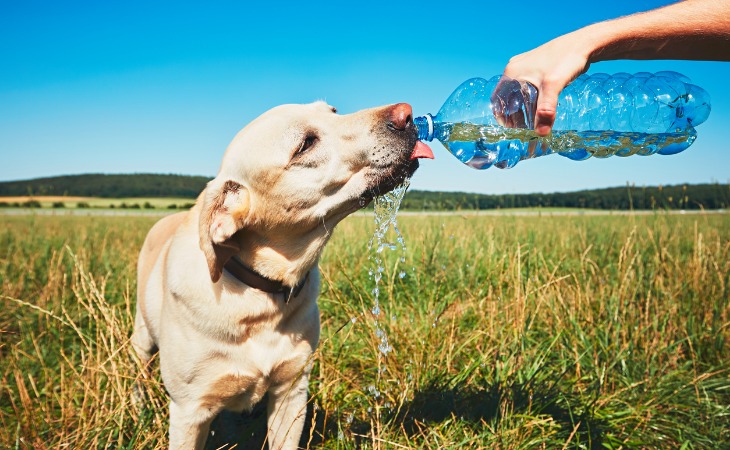When the temperatures start to rise, we need to take special care of our bodies to withstand the heat. This is the case for our pets as well. To help your pet get through the summer, you can protect them by doing a few simple yet effective things. Let’s take a look at how to protect your dog from the heat.
Protecting your dog from the summer heat
While we all love a bit of sun, it can sometimes be our enemy. If it too hot outside, our bodies react to this and it can lead to serious health problems, both in humans and dogs.
Is my dog hot?
Dogs will not tell you when they are feeling too hot. They won’t even try to make you understand their discomfort. However, if you observe them carefully, you will see a few hints that show that your dog might be feeling too hot.
Just like us, the amount of heat a dog can handle varies according to the individual. Some dogs will feel hot at 25°C ( ≈ 77 °F), while others will still feel okay when temperatures reach 30°C ( ≈ 86 °F). The difference between their tolerance can be caused by their age, health issues, or the breed. For example, an older dog will find it more difficult to tolerate hot temperatures.
Brachycephalic dogs, which are dogs with flat faces, have a harder time dealing with the heat because they have a more difficult time breathing. This is the case as well for dog who do like hot weather or overweight dogs.
Certain medical treatments can also influence and lower a dog’s tolerance to heat.
Intense exertion or staying in an unventilated space, such as a car, will also cause problems for dogs in hot weather.
Finally, like us, dogs get tired with high temperatures. If they can’t rest properly (when it’s too hot at night, for example), their body will be more sensitive to heat.
Keep an eye on your dog when it’s hot out
There are different ways that dogs act that can hint that your dog is suffering because of the heat:
- If your pet’s behavior or body language changes, you need to stay vigilant. A lively dog that has trouble moving or a very friendly animal that becomes more aggressive are warning signs. The dog may be hot and not feeling well.
- Has your dog’s breathing pattern changed? Is your dog panting faster? If you notice that your dog’s panting is abnormally loud, this is also a warning sign.
- If their nose is hotter than usual, this is not normal. Their body may be having trouble regulating its temperature.
These signs are the first to appear when a dog experiences heat stroke or hyperthermia.
But it can get complicated. If left unchecked, your dog may start to shake, feel dizzy, vomit, and hypersalivate. The inside of their lips and tongue may turn blue. In addition, their heart rate may increase and their body temperature may rise. For reference, a dog’s normal temperature is between 38°C and 39°C (≈ 100.4°F and 102.2°F). All of these symptoms indicate that your pet’s temperature is approaching or has exceeded 40°C (≈ 104°F) and this is dangerous.
A heat stroke can lead to the death in some cases. Therefore, it is essential to react before this happens in order to protect your dog from the heat.

What can you do to protect your dog from the heat?
To avoid any serious problems, the first thing to do is to avoid heat stroke. And for that, several things can be done to overcome high temperatures.
Water
To keep a dog refreshed and cooled down, water is a must. It is also important to keep their bowl filled with clean, fresh water. If your dog goes outside with you, remember to always take a bowl and bottle of water with you so that they can drink regularly. Try to keep the water in a cool place or use a thermos.
If your dog is not a big drinker, feel free to cheat a little to get them to drink. For example, you can add a few drops of vanilla or meat extract to the bowl to get your dog to drink more.
Water is also present in food. If you give your pet a homemade food, you can add zucchini which is very rich in water. You can also add watermelon to keep them hydrated.
Cold treats for your dog
When humans are hot, they typically want to eat ice cream to cool down. Dogs, on the other hand, should avois eating ice cream because it could cause diarrhea. It is especially important to not give ice creal with any form of chocolate or macadamia nuts because they are toxic for dogs.
It’s possible to make your cold treat for your dog. Start by mixing low-fat plain yogurt with crushed fruit. Do not to use grapes because they are toxic for canines. You can also make a cold snack for your dog with low-fat and low-salt bouillon cubes. These mixes can be given as ice cubes to your dog.
Refresh your dog in different ways
Even if your dog likes the sun, they should not stay under the heat for too long. If you dog doesn’t want to move, you can put up an umbrella or towel to keep them in the shade. You can also put out a fan so that your dog can enjoy a cool breeze. Keep your dog’s eyes and ears as far from away from the fan as possible.
Starting to notice that your dog is hot? Wet a towel, wring it out, and put it on your pet’s body. You can also use a water spray bottle that you’ve put in the refrigerator for a few hours. However, make sure that your dog likes it. Some dogs hate it and run away!
You can also use a wet glove to moisten areas such as their paw pads, belly, nose, and their neck.
Do you have room in your garden or on the balcony? Investing in a dog pool can be a great way to keep your dog cool.
Invest in accessories to protect your pooch from the heat
There are many accessories available today that are designed to help a dog withstand the heat. From bandanas to vests to cooling mats, it can be a good idea to invest in one to help your pet withstand the heat. Put the accessory in the refrigerator for a few hours after wetting it. It stays effective for several hours and is quite popular with dogs.
Is your dog already too hot?
If you dog is showing some of the symptoms that we mentioned earlier, you will need to react quickly to prevent your dog’s heat stroke from getting worse.
Help a dog with advanced hyperthermia
Place them in the shade as soon as possible and place a cool, damp towel on their body and neck. However, it’s important that the towels are not too cold. Thermal shock can be harmful. For the same reason, do not immerse your dog in a bath of very cold water because this could cause hydrocution.
You can also offer your dog water. With that being said, do not force them to drink. Moisten their lips inside and out with your finger, gently. Normally, they will lick their lips. If your dog doesn’t, the case is more urgent and you will have to take your pet to the nearest veterinarian without as soon as possible. Wrap your dog in a wet towel or sheet and tell your veterinarian that you are bringing in a dog with hyperthermia. It’s important to be very quick to keep your dog safe.

